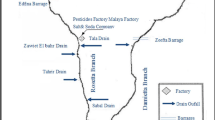Abstract
This article describes the use of a combined treatment system, which includes an aquatic treatment pond withTypha latifolia Linn. (Typhaceae) as the dominant species and a stabilization pond, to treat the wastewater from a Pn/Zn mine at Shaoguan, Guangdong Province, China.
In 1983, it was noted thatT. latifolia bloomed in areas affected by the wastewater emitted from the mine, hence a combined purification system was subsequently built.
The influent contained high levels of total suspended solids (4635 mg/liter), chemical oxygen demand (14.5 mg/liter) as well as Pb (1.6 mg/liter) and Zn (1.9 mg/liter). The results of the effluent after treatment showed that the total suspended solids, chemical oxygen demand, Pb, and Zn had been reduced by 99%, 55%, 95%, and 80% respectively. The results of plant tissue analysis indicled thatT. latifolia assimilated significant amounts of Pb and Zn, especially in the root portion.
During 1986 several species of algae and fish were present in the pond, usually with a higher density in areas containing lower metal concentrations in the water.
Similar content being viewed by others
Literature Cited
Allen, S. E., H. M. Grimshaw, J. A. Parkensin, and C. Quarmby. 1974. Chemical analysis of ecological materials. Blackwell Scientific, Oxford, 569 pp.
American Public Health Association. 1985. Standard methods for the examination of water and wastewater. APHA, Washington, 1267 pp.
Bowmer, K. H. 1987. Nutrient removal from effluents by an artificial wetland: Influence of rhizosphere aeration and preferential flow studied using bromide and dye tracers.Water Research 21:591–599.
Bradshaw, A. D., and T. McNeilly. 1981. Evolution and pollution. Edward Arnold, London, 76 pp.
Lawson, G. J., P. F. Cooper, and A. G. Boon. 1987. Reedbed treatment of sewage in UK. Draft paper to international conference on biology in water management. Veszprem, Hungary, 25–28 May 1987.
McNeilly, T., and A. D. Bradshaw. 1968. Evolutionary process in populations of copper-tolerantAgrostis tenuis Sibt.Evolution 22:108–118.
Reddy, K. R. 1983. Fate of nitrogen and phosphorus in a wastewater retention reservoir containing aquatic macrophytes.Journal of Environmental Quality 12:137–141.
Sharma, H. P., C. Polprasert, and K. K. Bhattarai. 1987. Physicochemical characteristics of fish ponds fed with septage.Resources and Conservation 13:207–216.
Sin, A. W., and M. T. L. Chiu. 1987. The culture of silver carp, bighead, grass carp and common carp in secondary effluents of a pilot sewage treatment plant.Resources and Conservation 13:231–246.
Smith, R. A. H., and A. D. Bradshaw. 1972. Stabilization of toxic mine wastes by the use of tolerant plant populations.Transactions of the Institution of Mining and Metallurgy (Section A) 81:230–237.
Spangler, F. L., C. W. Fetter, and W. E. Sloey. 1977. Phosphorus accumulation-discharge cycles in marshes.Water Resources Bulletin 13:1191–1201.
Stowell, R., R. Ludwig, J. Colt, and G. Tchobanoglous. 1980. Toward the rational design of aquatic treatment systems. Department of Civil Engineering, University of California, Davis, California, 24 pp.
Stowell, R., R. Ludwig, J. Colt, and G. Tchobanoglous. (1981). Concepts in aquatic treatment system design.Journal of the Environmental Engineering Division 107:919–940.
Tan, C., C. Wang, G. Tai, J. Dong, and S. Yu. 1986. Studies on removal of phenol from polluted water by water hyacinths. II. Experiments on the tissue, cell and homogenate level.Acta Scientiae Circumstantiae 6:216–223 (in Chinese with English summary).
Wang, C., S. Xu, Z. Wang, C. Tan, G. Tai, and S. Yu. 1986. Studies on removal of phenol from polluted water by waterhyacinths. I. Pot and oxidation pond experiments and effects of some environmental conditions on removal of phenol.Acta Scientiae Circumstantiae 6:207–215 (in Chinese, with English summary).
Wolverton, B. C., R. C. McDonald, and W. R. Ruffer. 1983. Microorganisms and higher plants for wastewater treatment.Journal of Environmental Quality 12:236–242.
Wong, M. H. 1982. Metal cotolerance to copper, lead and zinc inFestuca rubra.Environmental Research 23:42–47.
Wong, M. H. 1987. Reclamation procedures of wastes contaminated by Cu, Pb and Zn.Environmental Management 10:707–713.
Wong, M. H., and A. D. Bradshaw. 1982. A comparison of the toxicity of heavy metals, using root elongation of rye grass,Lolium perenne.New Phytologist 91:255–261.
Author information
Authors and Affiliations
Additional information
Paper was presented in part at the conference “The Use of Constructed Wetlands in Water Pollution Control” held 24–28 September 1990, Cambridge, UK.
Rights and permissions
About this article
Cite this article
Lan, C., Chen, G., Li, L. et al. Use of cattails in treating wastewater from a Pb/Zn mine. Environmental Management 16, 75–80 (1992). https://doi.org/10.1007/BF02393910
Issue Date:
DOI: https://doi.org/10.1007/BF02393910




